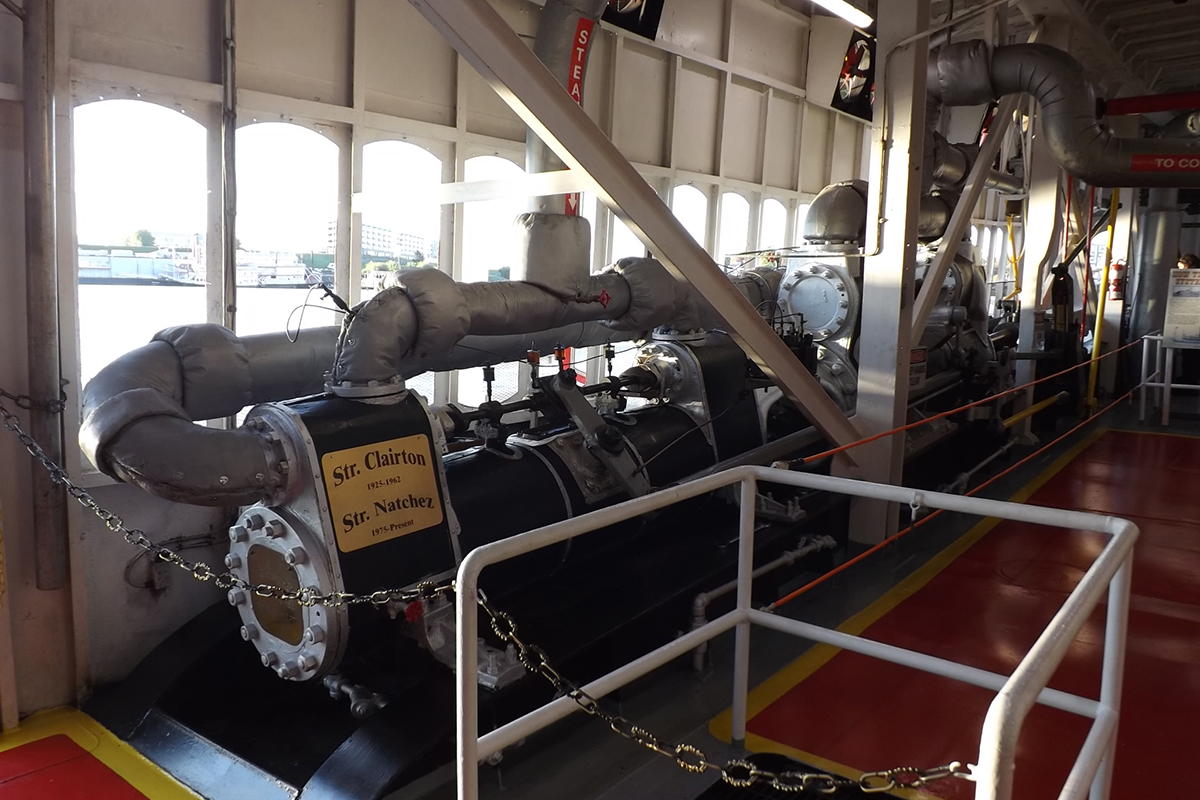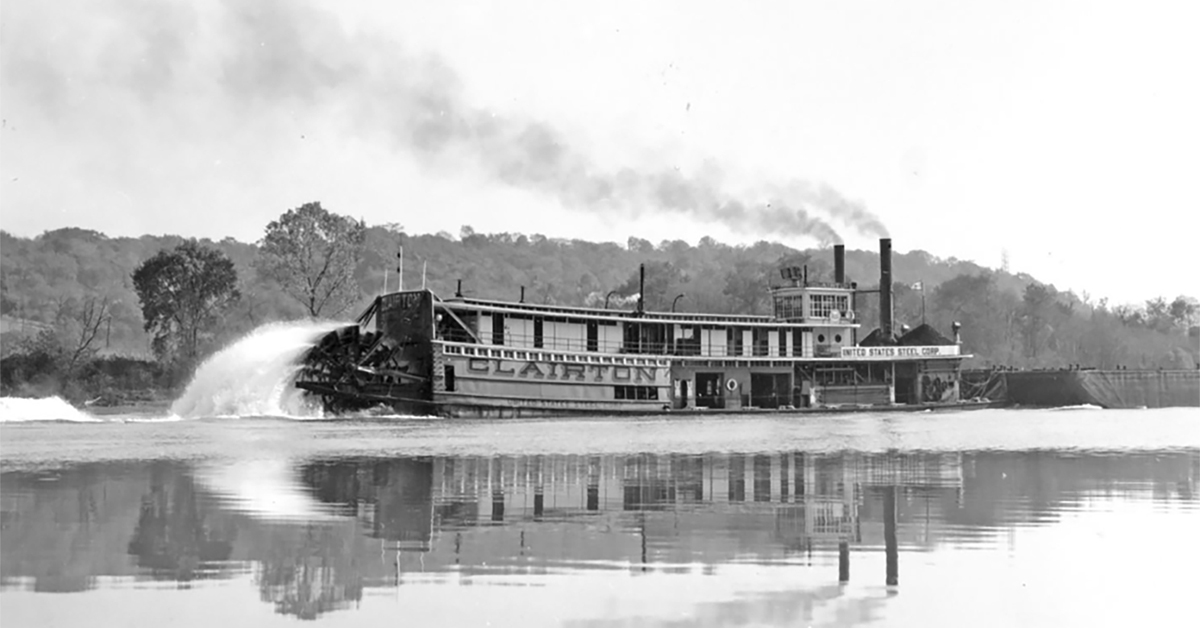Nine excursion vessels attended the America’s River Roots festival in Cincinnati October 8–12. Two of those were steamboats: the iconic, 111-year-old Belle of Louisville, a bona fide national historic landmark, and the magnificent steamer Natchez. The Natchez, now 50 years old, is a youngster compared to Belle ( see The Waterways Journal, April 21, 2025). The engines that turn the sternwheel of the Natchez, though, are nearly twice as old.
The Carnegie Steel Company built a series of steam sternwheel towboats in the 1920s. They all were very similar, with a 147.7-foot by 33-foot steel hull built by the American Bridge Company at Ambridge, Pa., on the Ohio River. The vessels were completed at the Coal Valley (Pa.) Marine Ways on the Monongahela River. One of those, the Youghiogheny (pronounced Yock-ah-genny), named after a tributary of the Mon River, was launched at Coal Valley in 1927. According to Way’s Steam Towboat Directory, Capt. Donald T. Wright, owner/publisher of The Waterways Journal, and Capt. Elmer Fancher were aboard for the launch.
The boat had 750 hp. from a pair of compound condensing engines from Federal Shipbuilding Corporation. Those engines had cylinders of 15- and 30-inch diameters and 7-foot stroke. According to an article written by the late Keith Norrington in 2019, the engines had an unusual locomotive valve gear called Walschaert’s after the Belgian inventor. There were four coal-fired boilers.
According to Way’s, the crew in April 1935 included Capt. James Hays, master; Capt. Henry E. Holloway, pilot; George Ehringer and Robert Young, engineers; Dewey Weaver, mate; and Andy Zollinger, steward. Ehringer was mentioned in the September 29, 2025, Old Boat Column as the first chief engineer on the W.H. Clingerman in 1918. Thirty-seven years later, he again was aboard that vessel (which was then called the W.P. Snyder Jr.) as honorary engineer to answer the last bell when it was tied off to become a floating exhibit at Marietta, Ohio.
Carnegie Steel was a division of U.S. Steel Corporation, and in October 1935 the Youghiogheny was renamed B.F. Fairless in honor of the president of U.S. Steel. The crew at the time included Capt. William A. Cook, master; Capt. Clayton Adams, pilot; Pat Comer, mate; George Ehringer, chief engineer; Robert Young, second engineer; and Ash Barnhart, steward. The boat would continue in the same trade of delivering Mon River coal to U.S. Steel facilities in the Pittsburgh area, while occasionally making trips to the South with finished steel products. In 1946, the Fairless received a new set of four return flue boilers, still coal fired.
Last week, this column detailed one of a series of eight 1,066 hp. towboats that Dravo built in 1951. Another of these went to U.S. Steel and was christened the B.F. Fairless. The steamer Fairless was then renamed Clairton.
There is a great YouTube video of an 8mm home movie taken on a cold winter day in 1959. The steamer Clairton is downbound with a loaded coal tow on the Mon River above the Union Railroad Bridge, known locally as the Bell Bridge, at Mile 21.7. There is snow on the ground, and the river is full of ice. Due to the cold, the steam and smoke emitting from the boat is quite dramatic, as is the sternwheel rolling through the ice. About halfway through the clip there is the added treat of the diesel B.F. Fairless, with an empty tow, passing the steamer that once carried the same name.
The Clairton ran until it was laid up in 1960, the same year that U.S. Steel received a new 1,066 hp. boat from Hillman Barge & Construction named John H. Elliott. The Clairton languished intact for several years, moored in Ten Mile Creek off of the Mon River. Some hoped the retired steam towboat would become a museum in the Pittsburgh area, but that never materialized. The Clairton was offered for sale in 1972. As detailed in the April 21 Old Boat Column, the Clairton was sold to the New Orleans Steamboat Company, which was building the Natchez at Bergeron Shipyard in Braithwaite, La.

The Clairton was first moved to Hillman at Brownsville, Pa., in September 1972 where the hull and machinery were evaluated. It was then towed to the Union Barge Line landing at Neville Island, Pa., on the Ohio River. The Clairton later was taken in tow from there by the UBL towboat Peace for the first leg of the trip south. Upon arriving at the Bergeron facility, the engines were removed for placement in the new excursion boat. The remains of the Clairton were then sold and became a restaurant that operated at various areas on the Gulf Coast. Keith Norrington reported seeing it at Fort Walton Beach, Fla., and this writer once saw it in Biloxi, Miss. It was later in Kenner, La., where it burned in 1984 and was scrapped.
The 1927-built engines are, as I write this, pushing the Natchez south on her return to New Orleans from River Roots in Cincinnati. With the graceful hull lines of the Natchez, which were designed by Alan Bates, the engines certainly don’t have to work as hard today as they did pushing barges for 33 years aboard the Youghiogheny/B.F. Fairless/Clairton.
Featured image caption: The Str. Clairton shoving an empty tow near the end of its career. (From the author’s collection)




